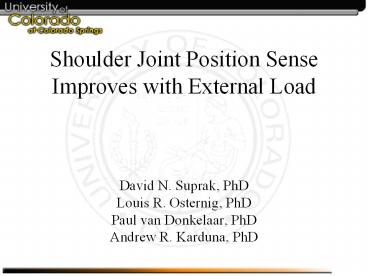Shoulder Joint Position Sense Improves with External Load - PowerPoint PPT Presentation
Title:
Shoulder Joint Position Sense Improves with External Load
Description:
End range (Salo and Tatton, 1993; Vangsness, 1995; Steinbeck, 2003) Musculotendinous ... Knee JPS with weight-bearing (Bullock-Saxton, 2001) Introduction ... – PowerPoint PPT presentation
Number of Views:45
Avg rating:3.0/5.0
Title: Shoulder Joint Position Sense Improves with External Load
1
Shoulder Joint Position Sense Improves with
External Load
- David N. Suprak, PhD
- Louis R. Osternig, PhD
- Paul van Donkelaar, PhD
- Andrew R. Karduna, PhD
2
Introduction
- Joint stability
- Functional activity
- Contributing factors
- Proprioception
- Feedback from limbs to CNS (Sherrington, 1906)
- Joint position sense (JPS) and kinesthesia (Dover
et al, 2003) - Muscle stiffness, coordination
- Importance for shoulder function
3
Mechanoreceptors
Introduction
- Capsuloligamentous
- Pacinian
- Ruffini
- Golgi tendon organ-like
- End range (Salo and Tatton, 1993 Vangsness,
1995 Steinbeck, 2003) - Musculotendinous
- Muscle spindles
- Golgi tendon organs
- Throughout ROM (Rymer and D'Almeida, 1980)
- Spindle sensitivity modulation (Burke, 1978
Durbaba, 2001 Jami, 1980)
4
Muscle Spindle
Introduction
- Alpha-gamma linkage (Edin and Vallbo, 1990)
- Increased stimulation and sensitivity w/ muscle
contraction (Burke, 1978 Durbaba, 2001 Jami,
1980)
5
JPS and Muscle Activation
Introduction
- Active JPS more accurate than passive (Aydin et
al, 2001 Edmonds et al, 2003 Potzl et al, 2004)
- Knee JPS with weight-bearing (Bullock-Saxton,
2001)
6
Effect of Elevation Angle
Introduction
- Decreased error approaching 90 deg (Suprak et al,
2006) - Torque
- Muscle spindle sensitivity
- Did not assess effect of muscle activation
directly
7
Purpose
Introduction
- Effect of altering external load at constant
position on repositioning error - Hypothesis
- Linear decrease in error with increased load
8
Subjects
Methods
- 24 healthy subjects
- (10 M, 14 F)
- Inclusion
- No hx of shoulder injury requiring surgery or
rehabilitation - Exclusion
- Limited elevation ROM
- Diagnosed neuromuscular disorders
9
Experimental Set-up
Methods
Head-mounted display
Humeral cuff and receiver
Load
Thoracic receiver
10
Load Calculation
Methods
- Baseline shoulder torque
- Arm length
- Body mass
- Segment mass, COM estimates (Dempster, 1955)
- 10, 20, 30, and 40 above baseline torque
- 5 Loading conditions
11
(No Transcript)
12
(No Transcript)
13
(No Transcript)
14
Absolute Error Calculation
Methods
15
Target Positions
Methods
20/70
50/70
35/50
5 trials 2 trials at 35/50 1 trial at distracters
20/30
16
Statistical Analysis
Methods
- Planned linear contrast
- One-way repeated measures ANOVA
- IV External resistance (5 levels)
- DV Vector error
- Analysis repeated for plane and elevation error
- a lt 0.05
17
Vector Error by Resistance
Results
18
Plane Error by Resistance
Results
19
Elevation Error by Resistance
Results
20
Discussion
- Non-linear pattern
- Internal representation
- Sampling variability
21
Discussion
- JPS increases with external load
- Muscle activation receptor sensitivity
- (Durbaba, 2001)
- Only in direction of load
- Role of musculotendinous receptors
- Injury prevention under high forces
22
Thank you































